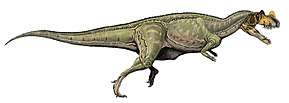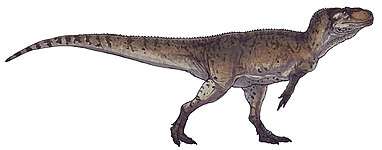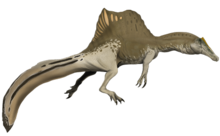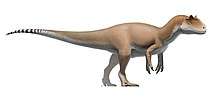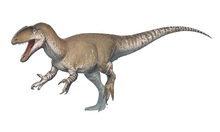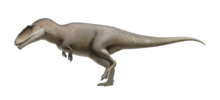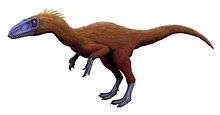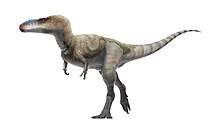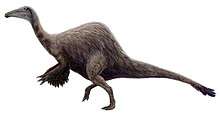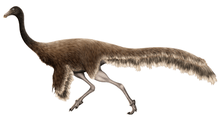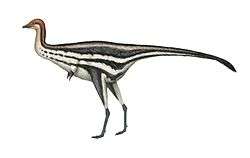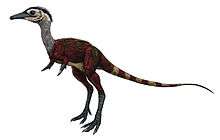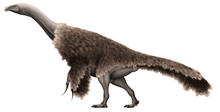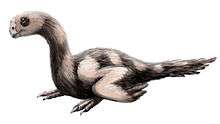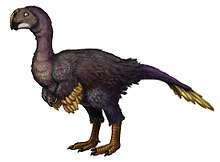Altispinax
Altispinax (/ˌæltɪˈspaɪnæks/; "with high spines") is a genus of large predatory theropod dinosaur from the Early Cretaceous (Valanginian, 140 to 133 million years ago) Wadhurst Clay Formation of East Sussex, England.
| Altispinax | |
|---|---|
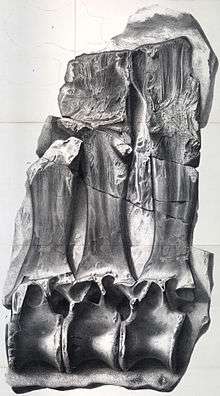 | |
| Holotype (NHMUK R1828) illustrated c. 1850s | |
| Scientific classification | |
| Kingdom: | Animalia |
| Phylum: | Chordata |
| Clade: | Dinosauria |
| Clade: | Saurischia |
| Clade: | Theropoda |
| Infraorder: | †Carnosauria |
| Genus: | †Altispinax von Huene, 1923 |
| Species: | †A. dunkeri |
| Binomial name | |
| †Altispinax dunkeri von Huene, 1923 | |
| Synonyms | |
| |
History
Probably during the early 1850s, fossil collector Samuel Husbands Beckles discovered some nodules with dinosaur bones in a quarry near Battle, East Sussex. These he sent to palaeontologist Richard Owen, who reported them in 1856.[1] Owen had a lithograph made by Joseph Dinkel of the main specimen, a series of three back vertebrae with very tall spines, whose image was also shown in an 1884 edition of an 1855 volume of his standard work on British fossil reptiles,[2] leading to the misunderstanding the fossils had been recovered close to 1884. Owen, who referred the specimens to Megalosaurus bucklandii, thought the vertebrae were part of the shoulder region and it has been assumed that he must have already known of the find in 1853 as he directed Benjamin Waterhouse Hawkins to put a hump on the back of his life-sized Megalosaurus sculpture in Crystal Palace Park, which again inspired other restorations from the 19th century.[3][4]
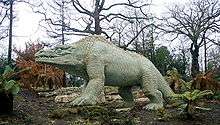
The fossil, now catalogued as NHMUK R1828, was probably found in a layer of the Hastings Bed Group dating from the late Valanginian age. It consists of a series of three posterior dorsal vertebrae. Owen also reported the presence in the nodules of two right ribs and two additional series of two dorsal vertebral centra each.[1] Olshevsky thought the holotype represented the eighth, ninth, and tenth dorsal vertebra; later researchers, however, have assumed them to be the tenth, eleventh and twelfth.[5]
In 1888, Richard Lydekker compared these vertebrae with material referred to Megalosaurus dunkeri, a Cretaceous species represented by a single tooth found in Germany.[6] In 1923 Friedrich von Huene created a separate genus for Megalosaurus dunkeri. He used the three vertebrae as the basis for this genus, noting that they were different from Megalosaurus, and created the name Altispinax (meaning "with high spines") based on their appearance. Many later researchers concluded that Megalosaurus dunkeri had therefore received a new genus name as Altispinax dunkeri, a combination actually used for the first time in 1939 by Oskar Kuhn.[7]
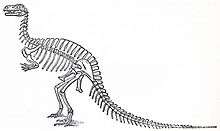
Later researchers considered Altispinax a nomen dubium because the single tooth was undiagnostic. No relationship could be proven between the tooth and the vertebrae. The vertebrae were therefore given a new name in 1988 by Gregory Paul. Paul considered them to represent a possible new species of Acrocanthosaurus, which he named Acrocanthosaurus? altispinax. The specific name was deliberately made identical to the old generic name, to emphasize that both referred to the vertebrae.[8] As indicated by the question mark, Paul himself was uncertain about this assignment. For this reason, in 1991 a new genus, Becklespinax, was named for the vertebrae by George Olshevsky, in honour of the original discoverer, Beckles. The new combination name of the type species Acrocanthosaurus? altispinax thus became Becklespinax altispinax.[9] The species names Altispinax altispinax[10][11] and Altispinax lydekkerhueneorum[12] are its junior objective synonyms. In 2016, a re-examination of this convoluted history of classification was published by Michael Maisch. Maisch concluded that von Huene, when he named Altispinax dunkeri, deliberately based the species on the vertebrae and not on the Megalosaurus dunkeri tooth. Because both species were based on different type specimens, later researchers were wrong to consider them the same species. Rather, according to Maisch's interpretation of the rules of the ICZN, Altispinax dunkeri (based on the tall-spined vertebrae) and Megalosaurus dunkeri (based on the tooth from Germany) are two distinct species that happen to share the same species name. Because the later names created by Paul and Olshevsky were based on the same vertebrae used to von Huene to name Altispinax dunkeri, all of those later names must be considered junior objective synonyms (different names for exactly the same fossil), and Altispinax dunkeri, having been named first, has priority as the correct name for this species.[13]
Other species
Four other species would be named within the genus Altispinax. In 1923 von Huene renamed Megalosaurus oweni Lydekker 1889, based on the metatarsus BMNH R2559, into Altispinax oweni.[14] In 1991 Olshevsky created a separate genus Valdoraptor for this species.[9] In 1932 von Huene renamed Megalosaurus parkeri Huene 1923 into Altispinax parkeri.[15] This species in 1964 was given the separate generic name Metriacanthosaurus.
Description

Paul in 1988 tentatively estimated that Altispinax weighed one tonne and was shorter than Acrocanthosaurus atokensis, itself by him estimated at the time as eight metres (26 ft) long.[8]
The three A. dunkeri back vertebrae from Sussex have about thirty-five centimetres high neural spines or processus spinosi, about as relatively tall as those of Ichthyovenator.[16] These show irregular rugosities on the upper third part. According to Ralph Molnar the two spines closest to the skull are ankylosed or fused. The single closest spine is only about two-thirds the height of the others and looks as it has broken off, while the spine behind partly overgrows the gap. This Molnar explained as a result of injury to a back frill, the wound later closing from behind.[5] In 2003, Darren Naish gave a different interpretation, suggesting the gap was natural. He denied that the front two vertebrae were ankylosed but observed that the spines of eleventh and twelfth vertebrae were joined at the top. The spines are also transversely expanded above, with a width of about fifty-five millimetres. Naish also pointed out that Owen had noted the large depressions on the neural arch sides and had explained them as a result of pneumatisation, the first time this phenomenon would explicitly have been observed with a dinosaur.[17][18] In 2006 however, it was reported that in 1837 Christian Erich Hermann von Meyer already had commented on this phenomenon with the Saurischia in general.[19] The discovery of a back crest incorporating only two high vertebrae in Concavenator, in 2010 provided corroboration that the short anterior Altispinax spine may be complete.[20]
Olshevsky originally assigned Altispinax to the Eustreptospondylidae. In 2003 Naish considered it a member of the Allosauroidea.[17] Most researchers give a less precise placement as Tetanurae incertae sedis.[21][22]
References
- Owen, R., 1856, Monograph on the fossil Reptilia of the Wealden Formation. Part IV. Palaeontographical Society Monographs 10, 26 pp
- Owen, R., 1855, Monograph on the fossil Reptilia of the Wealden and Purbeck formations. Part II. Dinosauria (Iguanodon). (Wealden). Palaeontographical Society Monographs 8. 54 pp
- "Re: _Becklespinax_". Archives of the DINOSAUR Mailing List. The Cleveland Museum of Natural History. 18 Feb 1997. Retrieved 25 May 2016.
- Naish, D. 2010. "Pneumaticity, the early years: Wealden Supergroup dinosaurs and the hypothesis of saurischian pneumaticity". In: Moody, R. T. J., Buffetaut, E., Naish, D. & Martill, D. M. (eds) Dinosaurs and Other Extinct Saurians: A Historical Perspective. Geological Society, London, Special Publications 343, pp. 229-236
- Molnar, R. E., 2001, Theropod paleopathology: a literature survey: In: Mesozoic Vertebrate Life, edited by Tanke, D. H., and Carpenter, K., Indiana University Press, p. 337-363.
- Lydekker, R. 1888. Catalogue of the Fossil Reptilia and Amphibia in the British Museum (Natural History), Cromwell Road, S.W., Part 1. Containing the Orders Ornithosauria, Crocodilia, Dinosauria, Squamata, Rhynchocephalia, and Proterosauria. British Museum of Natural History, London, 309 pp
- Kuhn, O., 1939, Saurischia — Fossilium catalogus I, Animalia, Pars 87. 's-Gravenhage, W. Junk, 1939, 124 pp
- Paul, G.S., 1988, Predatory Dinosaurs of the World. Simon & Schuster, New York 464 pp
- Olshevsky, G., 1991, A revision of the parainfraclass Archosauria Cope, 1869, excluding the advanced Crocodylia. Mesozoic Meanderings 2, 196 pp
- Rauhut, O.W.M., 2000, The interrelationships and evolution of basal theropods (Dinosauria, Saurischia). Ph.D. dissertation, University of Bristol, 440 pp
- Rauhut, O.W.M., 2003, The Interrelationships and Evolution of Basal Theropod Dinosaurs. Special Papers in Palaeontology no. 69, London, The Palaeontological Association 213 pp
- Pickering, S., 1995, Jurassic Park: Unauthorized Jewish Fractals in Philopatry, A Fractal Scaling in Dinosaurology Project, 2nd revised printing, Capitola, California, 478 pp
- Maisch, M.W. (2016). The nomenclatural status of the carnivorous dinosaur genus Altispinax v. Huene, 1923 (Saurischia, Theropoda) from the Lower Cretaceous of England. Neues Jahrbuch für Geologie und Paläontologie - Abhandlungen, 280(2): 215-219. doi:10.1127/njgpa/2016/0576
- Huene, F. von (1923). "Carnivorous Saurischia in Europe since the Triassic". Bulletin of the Geological Society of America, 34: 449-458.
- Huene, F. von (1932). Die fossile Reptil-Ordnung Saurischia, ihre Entwicklung und Geschichte. Monographien zur Geologie und Palaeontologie, Series 1, vol. 4(1-2), 361 pages
- Allain, R., Xaisanavong, T., Richir, P. & Khentavong, B. 2012. "The first definitive Asian spinosaurid (Dinosauria: Theropoda) from the Early Cretaceous of Laos". Naturwissenschaften 99(5): 369-377
- Naish, D., 2003, "A definitive allosauroid (Dinosauria; Theropoda) from the Lower Cretaceous of East Sussex", Proceedings of the Geologists’ Association 114: 319-326
- Naish, Darren; Martill, David M. (2007). "Dinosaurs of Great Britain and the role of the Geological Society of London in their discovery: basal Dinosauria and Saurischia". Journal of the Geological Society. 164 (3): 493–510. doi:10.1144/0016-76492006-032.
- O’Connor, P.M. 2006. "Postcranial pneumaticity: an evaluation of soft-tissue influences on the postcranial skeleton and the reconstruction of pulmonary anatomy in archosaurs". Journal of Morphology, 267: 1199–1226
- "Archived copy". Archived from the original on 2016-05-30. Retrieved 2016-05-15.CS1 maint: archived copy as title (link)
- Holtz, T. R.; Molnar, R. E.; Currie, P. J. (2004). "Basal Tetanurae". In Weishampel, D. B.; Dodson, P.; Osmolska, H. (eds.). The Dinosauria (2nd. ed.). Berkeley: University of California Press. pp. 71–110.
- M. T. Carrano, R. B. J. Benson, and S. D. Sampson, 2012, "The phylogeny of Tetanurae (Dinosauria: Theropoda)", Journal of Systematic Palaeontology 10(2): 211-300
